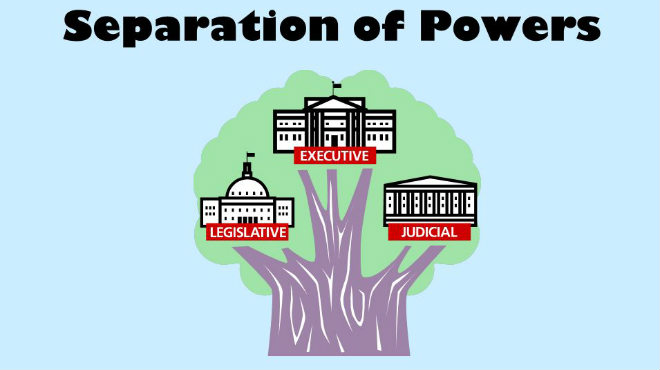This article has been written by Chaudhary Nikhat Fatima, currently pursuing Law from Rizvi Law College. Picture Credits to Lawrato.com
History has time and again shown that unlimited power in the hands of one person or group in most cases means that others are suppressed or their powers curtailed. The separation of powers in a democracy is to prevent abuse of power and to safeguard freedom for all and thus Separation of power is an essential element in order to make the government work in an appropriate way.
Meaning
The term separation of powers was first introduced by Montesquieu, his theory lay that it was in the nature of authority to abuse it and that unless clear limitations we’re laid down, the arbitrary rule would be inevitable. According to him moderation in the exercise of government authority was the essential requisite of a good government. In order to realize such moderation, each power should be exercised by a different organ of government and among the various organs of government, there should be a system of checks and balances so that one organ might not become all-powerful.
In every state, there are three kinds of powers:
LEGISLATURE:
The chief function of the legislature is to enact laws.
- It is the basis for the functioning of the other two organs, the executive and the judiciary.
EXECUTIVE
The executive is the organ that implements the laws enacted by the legislature and enforces the will of the state.
- It is the administrative head of the government.
JUDICIARY
The judiciary is that branch of the government that interprets the law, settles disputes, and administers justice to all citizens.
- The judiciary is considered the watchdog of democracy, and also the guardian of the Constitution.
Significance of Doctrine
When the legislative and executive powers are united in the same persons or in the same body of magistrates there can be no liberty, because apprehensions may arise, lest the same monarch or separate should enact tyrannical laws and execute them in a tyrannical manner. There is no liberty if judicial power is not separated from the legislative and executive. Where It joined with the legislative, the life and liberty of the subject would be exposed to arbitrary control, for the judge would be then the legislator. When it joined the executive power, the judge might behave with violence and oppression. Hence, the importance of the Separation of Powers doctrine can be summed up as follows:
- Keeps away autocracy
- Safeguards individual liberty
- Helps create an efficient administration
- Judiciary’s independence is maintained
- Prevents the legislature from enacting arbitrary or unconstitutional laws
Constitutional Status
The doctrine of separation of powers is a part of the basic structure of the Constitution, although not specifically mentioned. The legislature cannot pass a law violating this principle. The functions of the three organs are specifically mentioned in the Constitution.
Article of the constitution that suggest separation on of Powers:
Article 50: This article puts an obligation on the State to separate the judiciary from the executive. But, since this falls under the Directive Principles of State Policy, it is not enforceable.
Article 123: The President, being the executive head of the country, is empowered to exercise legislative powers (Promulgate ordinances) in certain conditions.
Articles 121 and 211: These provide that the legislatures cannot discuss the conduct of a judge of the Supreme Court or High Court. They can do so only in case of impeachment.
There is a system of checks and balances wherein the various organs impose checks on one another by certain provisions.
Checks and Balances
In India, a separation of functions rather than of powers is followed. Unlike in the US, in India, the concept of separation of powers is not adhered to strictly. However, a system of checks and balances have been put in place in such a manner that the judiciary has the power to strike down any unconstitutional laws passed by the legislature.
Today, most of the constitutional systems do not have a strict separation of powers between the various organs in the classical sense because it is impractical. The makers of the American Constitution were conscious of the impossibility of applying an absolute separation of powers. Hence, they incorporated another theory known as the “Theory of Checks and Balances”. They thought if the principle of separation of powers is carried too far, it would make the Constitutional system unworkable Hence, they devised a system of check upon each other so that none can become tyrannical. The principle is designed to bring about an overall equilibrium and to prevent the tendency of each branch of government to become autocratic and irresponsible in its own particular field. In order to prevent the abuse of power on the part of any organ of the government, the other two have been given the power to act like checks. This means that no branch of government has unlimited powers even in its own sphere.
- In Indira Nehru Gandhi’s case, Chandrachud J. observed – No Constitution can survive without a conscious adherence to its fine checks and balances. Just as courts ought not to enter into problems intertwined in the political thicket, Parliament must also respect the preserve of the courts. The principle of separation of powers is a principle of restraint which “has in it the precept, inmate in the prudence of self-preservation; that discretion is the better part of valor”.
Relation between Legislature and Judiciary
Even though the functions of the executive and the judiciary are well-defined in the Constitution, the system of checks and balances ensures that each one can impose checks on the other.
The judiciary can strike down laws that it considers unconstitutional or arbitrary.
The legislature, on its part, has protested against judicial activism and tried to frame laws to circumvent certain judgments.
Judicial activism is said to be against the principle of separation of powers.
There have been instances where the courts have issued laws and policies through judgments. For example, the Vishaka Guidelines where the SC issued guidelines on sexual harassment.
Relation between Legislature and Executive
The Constitution states that the executive branch of the State (Council of Ministers) shall be collectively responsible to the Legislature (Lok Sabha). This implies that the Parliament should supervise the work of the government and hold it accountable for its actions.
In a parliamentary form of government, the executive is not separated from the legislature in that the members of the council of ministers are members of the legislature.
The executive loses power when it loses the confidence of the legislature. The executive/council of ministers is dismissed if it loses the legislature’s confidence before its tenure is over. So, the legislature controls the executive through a vote of no-confidence.
The head of government and head of state are different. The head of the government is the Prime Minister while the head of state is the President.
The parliament makes laws in general broad terms and delegates the powers to the executive to formulate detailed policy and implement them.
In a presidential form of government, the executive is not accountable to the legislature. One person is the head of both the State as well as the government. A minister need not be from the legislature.
Relation between Executive and Judiciary
There are several provisions in the Constitution that make the judiciary independent. This is because, it is believed that for a democracy to remain efficient and effective, the judiciary must be independent. The judiciary is said to be the guardian of the constitution. If the executive also assumes judicial powers, that sort of a government tends to become oppressive.
However, there are some judicial functions which are performed by the executive as well. They are:
The appointments of the judges are made by the executive.
The President and the Governors also enjoy the power to pardon, reprieve, etc. These are direct judicial functions.
Under the system of administrative adjudication, the executive agencies have the power to hear and decide cases involving particular fields of administrative activity.
The judiciary also performs some executive functions. It can review the actions of the executive and declare them void if found unconstitutional.
Separation of Powers in other countries
Separation of power in the USA
The United States Constitution has a more rigid separation of powers than the Constitutions of other democracies. In the United States Constitution, Article 1 Section I gives Congress only those “legislative powers herein granted” and proceeds to list those permissible actions in Article I Section 8, while Section 9 lists actions that are prohibited for Congress.
The vesting clause in Article II places no limits on the Executive branch, simply stating that “The Executive Power shall be vested in a President of the United States of America.
Separation of power in England
Although the doctrine of separation of power plays a role in the United Kingdom’s constitutional doctrine, the UK constitution is often described as having “a weak separation of powers”. For example, in the United Kingdom, the executive forms a subset of the legislature, as did—to a lesser extent—the judiciary until the establishment of the Supreme Court of the United Kingdom.
The Supreme Court holds “The judicial Power” according to Article III, and it established the implication of Judicial review in Marbury v. Madison. Checks and balances allow for a system-based regulation that allows one branch to limit another, such as the power of Congress to alter the composition and jurisdiction of the federal courts.
Some other countries
The Commonwealth of Australia Constitution Act, 1900 clearly demarcates the boundaries of the three organs and therefore provides for a very rigid separation of powers.
Similarly, the French Constitution also provides for separation of powers and divides the national government into the executive, the legislative, and judicial branches.
Latest Posts
- Job opportunity at EXO Edge, Sahibzada Ajit Singh Nagar, Punjab, India: Apply Now!!

- Internship opportunity at Vishwas Advisors, Kalyan, Maharashtra, India: Apply Now!!

- Internship opportunity at Kulfi Collective, Mumbai, Maharashtra, India: Apply Now!

- Job opportunity at The Neotia University, Diamond Harbour, West Bengal, India: Apply Now !!

- Job opportunity at Morgan Stanley, Mumbai, Maharashtra, India: Apply Now!!

- Job opportunity at VISA INTELLIGENCE CONSULTANCY LLP, New Delhi, Delhi, India: Apply Now!!

- Job opportunity at Amazon Web Services (AWS), Gurugram, Haryana, India: Apply Now!!

- Job opportunity at Stelcore Management Services Private Limited, Mumbai, Maharashtra, India: Apply Now!!

- Job opportunity at Zscaler, Sahibzada Ajit Singh Nagar, Punjab, India: Apply Now!!

- Job opportunity at Irish Expert, Delhi, India: Apply Now!!

- Job opportunity at UnitedLex · Gurgaon, Haryana, India: Apply Now!

- Internship opportunity at Vineforce · Nabha, Punjab, India: Apply Now!!

- CLAT-Peeps! (10)
- Current Affairs (2)
- competitions (132)
- Conferences and Seminars (201)
- Webinar (1)
- Course and Workshops (107)
- Debates (46)
- Eassy Competitions (69)
- Fellowships & Scholarships (56)
- Guest Blogs (6)
- important (29)
- Internships and Jobs (2,317)
- interviews (8)
- moot court (180)
- Opportuintes (2,731)
- Job Opportunity (1,191)
- opportunity (2,559)
- Call for papers (475)
- Quizes,fests and others (298)
- Work Opportunity (836)
- Our Blog (1,049)
- Administrative Law (17)
- ADR (13)
- Arms Act (2)
- Case Analysis (205)
- Company law (36)
- Constitutional Law (143)
- Consumer Protection Act (17)
- Contract Law (62)
- CPC (10)
- Criminal Law (140)
- Cyber Law (13)
- Environmental Laws (30)
- Evidence Act (20)
- Family Law (12)
- General (205)
- International Humanitarian Law (8)
- International law (23)
- IPR (10)
- Jurisprudence (13)
- labor laws (7)
- Maritime Laws (1)
- Partnership Act (2)
- personal law (33)
- Taxation (10)
- Tort (64)
- Transfer of Property (2)
- Our Services (11)
- career advice (2)
- others (6)
- Top Stories (524)
- Uncategorized (720)
- November 2023
- October 2023
- September 2023
- August 2023
- July 2023
- June 2023
- May 2023
- April 2023
- March 2023
- February 2023
- January 2023
- December 2022
- November 2022
- October 2022
- September 2022
- August 2022
- July 2022
- June 2022
- May 2022
- April 2022
- March 2022
- February 2022
- January 2022
- December 2021
- November 2021
- October 2021
- September 2021
- August 2021
- July 2021
- June 2021
- May 2021
- April 2021
- March 2021
- February 2021
- January 2021
- December 2020
- November 2020
- October 2020
- September 2020
- August 2020
- July 2020
- June 2020
- May 2020
- April 2020
- February 2020
- January 2020
- November 2019

